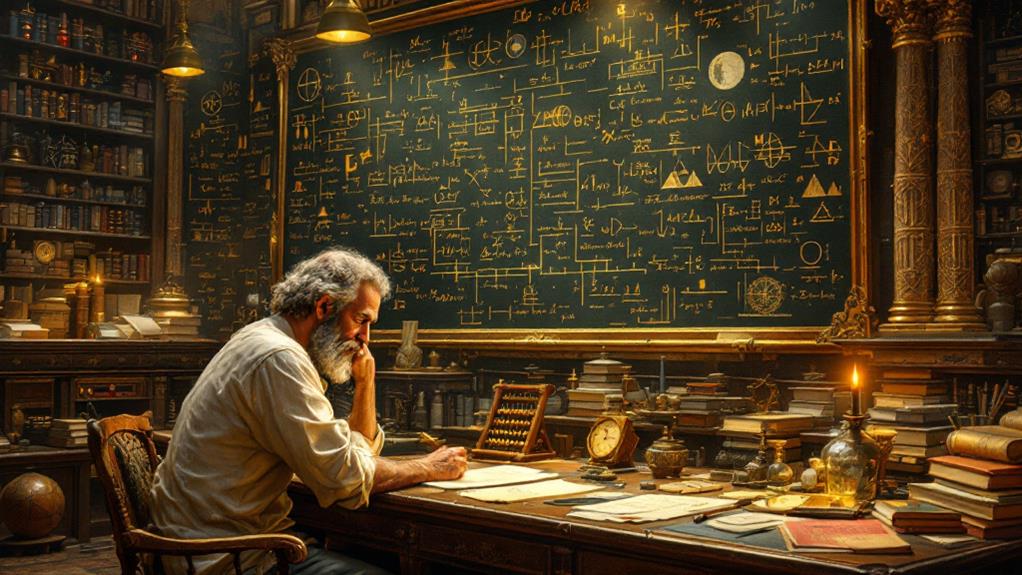The History of Formal Science: Understanding the Foundations of Logic and Mathematics

You're exploring the rich tapestry of logic and mathematics' history, beginning with ancient philosophers like Plato and Aristotle, who laid foundational concepts. Euclidean geometry solidified mathematical precision, later expanded by Islamic scholars like Al-Khwarizmi during the Islamic Golden Era. The Renaissance introduced crucial changes with Cartesian coordinates and the dawn of calculus. Enlightenment thinkers emphasized empirical and deductive reasoning, reshaping logical frameworks. The formalization of theories in the nineteenth century set the stage for dramatic twentieth-century innovations like set theory and computational logic, which now underpin modern technology. Each step reveals how these ideas evolved and influenced current practices.
Ancient Philosophical Roots
The ancient philosophical roots of formal science trace back to the intellectual inquiries of early Greek thinkers. As you investigate these origins, you'll find the Pre-Socratic Philosophers laying the groundwork with their quest for understanding the universe's fundamental nature. They sought to define Mathematical Ontology and unravel the Epistemological Foundations of knowledge. Their inquiries set the stage for later thinkers who refined these ideas.
Plato's influence is undeniable, as his Platonic Ideals paved the way for abstract thinking. He emphasized the existence of perfect forms, which are essential when you consider the Metaphysical Implications in formal science. Aristotle, Plato's student, further advanced this intellectual tradition. With his Aristotelian Syllogism, he provided a method to derive outcomes from premises, a cornerstone of logical reasoning.
The Stoics, with their focus on Stoic Logic, contributed by developing a system that emphasized consistency and coherence in argumentation. Their Rhetorical Techniques highlighted the importance of persuasive communication in philosophical discourse. As you investigate these ancient roots, you'll appreciate how their pioneering thoughts still influence today's logical and mathematical frameworks. Through their inquiries, these early thinkers laid the foundation for formal science.
Birth of Greek Logic
Imagine diving into the lively world of ancient Greece, where logic as a formal discipline initially blossomed. You're witnessing the birth of Greek logic, a crucial period that laid the groundwork for modern reasoning. Picture Socrates employing the Socratic method, a technique fostering deep inquiry through questions, which helped shape logical thinking by challenging assumptions and uncovering contradictions. This method's influence paved the way for Aristotle's syllogism, a form of deductive reasoning where outcomes follow from two premises.
You're intrigued by Aristotle's work, establishing formal definitions and rules for logical thought. His syllogism became an fundamental tool for constructing arguments, and it offered a clear framework for understanding logical relationships. As you investigate further, you'll encounter logical paradoxes that challenged thinkers to refine their understanding of reasoning's limits, pushing the boundaries of epistemological foundations.
The philosophical implications of these developments are profound, as they questioned the nature of truth and knowledge. In your inquiry, truth tables might not yet be developed, but the seeds of binary logic are sown, setting the stage for future advancements. Greek logic's legacy is a reflection of humanity's quest for clarity and understanding.
Euclidean Geometry's Influence

Step into the realm of Euclidean geometry, where five foundational postulates laid the groundwork for centuries of mathematical investigation. By embracing these geometric axioms, you reveal powerful tools for spatial reasoning and problem-solving. Euclid's approach transformed mathematics by introducing a structured method to derive truths through Euclidean proofs, emphasizing mathematical rigor and precision.
In Euclidean geometry, classical theorems such as the Pythagorean theorem and the properties of parallel lines arose from these postulates. You examine these theorems by constructing geometric figures that adhere to strict rules, revealing the beauty of logic and order. Geometric constructions, like bisecting angles or drawing perpendicular lines, stem from Euclid's axiomatic system, showing how complex shapes emerge from simple concepts.
Dimensional analysis in Euclidean geometry helps you understand the relationships between points, lines, and planes. It allows you to visualize and quantify space, providing insights into both two-dimensional and three-dimensional figures. By engaging with these ideas, you gain a deeper appreciation for the elegance and consistency of Euclidean methods. As you investigate this world, you witness how Euclidean geometry's influence extends beyond mathematics, shaping the way we perceive and interact with the physical universe.
Algebra's Islamic Golden Age
While Euclidean geometry offered a structured approach to spatial reasoning, the Islamic Golden Period brought a transformative phase for algebra. During this time, Islamic scholars made significant algebraic contributions that profoundly shaped the field. You'll find that these scholars, like Al-Khwarizmi, played an essential role in developing new numerical systems and solving complex equations. Their mathematical texts laid the groundwork for modern algebra, introducing methods that are still in use today.
As you investigate this period, notice how cultural exchanges between Islamic regions and other civilizations enriched mathematical knowledge. These interactions facilitated scientific translations of Greek, Indian, and Persian works into Arabic, which allowed Islamic scholars to refine existing theories and make groundbreaking revelations. Educational institutions, such as the House of Wisdom in Baghdad, became hubs for learning and innovation, fostering an environment where scholars could collaborate and share insights.
Geometric advancements during this period also complemented algebraic progress, as scholars applied algebra to solve geometric problems. This synergy between algebra and geometry pushed the boundaries of what was mathematically possible, leading to a deeper understanding that would influence future generations of mathematicians worldwide.
Renaissance Mathematical Advances

The Renaissance period marked a lively age of mathematical advancement, fueled by a renewed interest in classical knowledge and a creative spirit. You'll find that Renaissance thinkers played a crucial role in transforming mathematics into a more rigorous and expressive discipline. Mathematical notation became more refined, allowing complex ideas to be communicated with clarity. This period saw the birth of cartesian coordinates, introduced by Renée Descartes, merging algebra and geometry to provide geometric perspectives that transformed how you visualize shapes and spaces.
The foundations of calculus began to take shape, laying the groundwork for future innovations. Symbolic representation advanced, offering a means to investigate mathematical concepts more abstractly and elegantly. Probability theories also emerged, guiding you in understanding the rules of chance and uncertainty. The Renaissance didn't merely focus on utility; it welcomed mathematical aesthetics, finding beauty in symmetry, patterns, and proportion.
Here's a summary of the key advancements:
- Mathematical Notation: Improved clarity and communication of complex ideas.
- Cartesian Coordinates: Bridged algebra and geometry.
- Calculus Foundations: Initiated investigation of change and motion.
- Probability Theories: Provided insights into uncertainty and chance.
These innovations laid the groundwork for modern mathematics, shaping how you perceive and engage with the world.
Enlightenment's Logical Revolution
Building on the Renaissance's mathematical advancements, the Enlightenment period ushered in a logical revolution that reshaped the intellectual landscape. You see, this age emphasized rational thought and mathematical rigor, driving a deeper understanding of the world. Thinkers like Descartes and Leibniz championed deductive reasoning, using it to tackle complex philosophical inquiries. By focusing on empirical evidence, they laid a foundation for scientific examination, demanding that claims be tested and verified. This emphasis on evidence-based knowledge led to significant epistemological shifts, altering how individuals approached truth and understanding.
Symbolic representation became an essential tool during this period. You'd notice how symbols allowed for clearer communication of complex ideas, making abstract concepts more accessible. The development of calculus, for example, showcased the power of symbolic manipulation in solving real-world problems. Logical paradoxes, once perplexing, became opportunities for refinement in logical systems.
These advances weren't just academic; they encouraged you to question and investigate, pushing the boundaries of what could be known. The Enlightenment's logical revolution wasn't merely a philosophical endeavor—it was a transformative movement that laid the groundwork for future innovation and revelation.
Nineteenth-Century Formalization

In the nineteenth century, formalization took center stage, transforming the landscape of mathematics and logic. You'll find that during this period, the development of formal systems became vital. This was when proof theory started to evolve, allowing mathematicians to investigate axiomatic foundations with newfound mathematical rigor. Logical frameworks were carefully constructed to underpin these systems, guaranteeing consistency and coherence.
- Symbolic Notation: Introduced to represent complex mathematical ideas succinctly, symbolic notation became a universal language for mathematicians. It allowed the expression of abstract concepts with precision, facilitating deeper understanding and communication.
- Set Theory: Emerging as a significant discipline, set theory laid the groundwork for modern mathematics. By focusing on the properties of sets, it addressed fundamental issues in mathematical logic and became a key component of formal systems.
- Quantifier Logic: This innovation extended the capabilities of logical frameworks, enabling more expressive statements about mathematical objects. It improved the ability to articulate claims involving quantities and relations, increasing the depth of logical analysis.
- Axiomatic Foundations: Establishing axiomatic foundations became a central goal. By defining clear starting points, mathematicians guaranteed that complex theories could be built systematically, improving the reliability and structure of mathematical knowledge.
Twentieth-Century Innovations
Twentieth-century breakthroughs transformed the landscape of formal sciences, ushering in a period of unprecedented innovation and investigation. You witnessed set theory's expansion, providing a robust framework for understanding mathematical structures. With category theory, you found a new way to connect different mathematical areas, emphasizing relationships and transformations between structures. This century saw the rise of proof theory, advancing how you approach the validity and structure of mathematical arguments.
Mathematical logic flourished, offering significant insights into formal semantics and the nature of mathematical truth. Axiomatic systems became more refined, allowing you to examine mathematics from a foundational perspective, ensuring consistency and completeness. This period also introduced the study of computational complexity, challenging you to analyze the efficiency of algorithms and understand the limits of computation.
You investigated algorithmic foundations, which became vital in the development of modern computer science. These innovations laid the groundwork for future advancements, influencing how you approach problems in mathematics and beyond. The twentieth century's contributions to formal sciences didn't just improve your understanding; they fundamentally reshaped the way you perceive logic, mathematics, and their interconnected domains.
Modern Computational Logic

Modern computational logic propels you into a domain where traditional logical principles meet cutting-edge technology. Here, you investigate how automated reasoning improves problem-solving capabilities and transforms theoretical concepts into practical applications. Logical frameworks form the backbone of this field, providing the structure needed for complex computational models and algorithmic logic to function effectively. These frameworks allow you to break down intricate problems, making them easier to analyze and solve.
In this exciting area, you'll find:
- Formal Verification: This process guarantees that systems behave as expected by rigorously checking their properties against desired specifications. It's vital for developing reliable software and hardware.
- Proof Assistants: These tools help you construct formal proofs with greater accuracy and efficiency. They offer invaluable support in verifying complex theorems and improving deductive systems.
- Model Checking: This technique automatically verifies finite-state systems, confirming they meet specified requirements. It's especially useful in hardware and software design to prevent costly errors.
- Algorithmic Logic: By using this, you can design algorithms that are not only efficient but also logically sound. It bridges the gap between theoretical logic and practical computation.
Embrace modern computational logic, and you'll reveal a world of possibilities in diverse scientific and technological domains.



